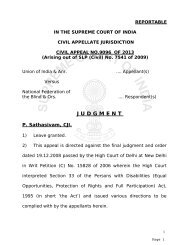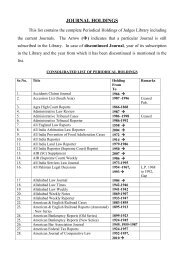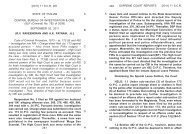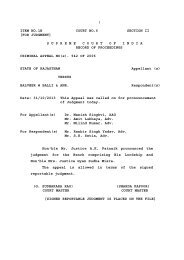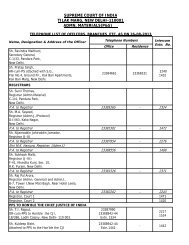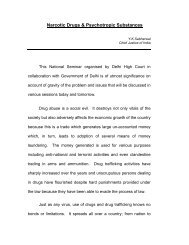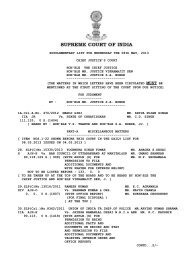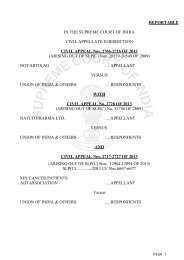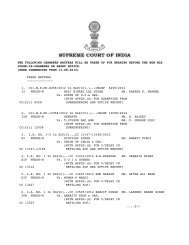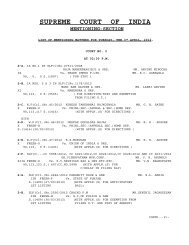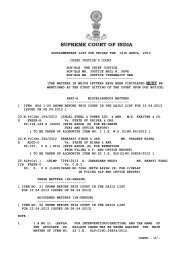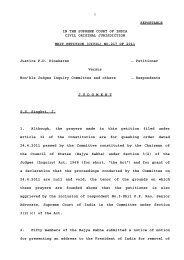Part No.IV - Supreme Court of India
Part No.IV - Supreme Court of India
Part No.IV - Supreme Court of India
You also want an ePaper? Increase the reach of your titles
YUMPU automatically turns print PDFs into web optimized ePapers that Google loves.
MAHADEV GOVIND GHARGE v. SPL. LAO UPPER KRISHNA<br />
PROJECT JAMKHANDI, KARNATAKA [ASOK KUMAR GANGULY, J.]<br />
42. The language <strong>of</strong> Order XLI Rule 22 <strong>of</strong> the Code fixes<br />
the period <strong>of</strong> limitation to be computed from the date <strong>of</strong> service<br />
<strong>of</strong> notice <strong>of</strong> hearing <strong>of</strong> the appeal upon the respondent/crossobjector<br />
and within one month <strong>of</strong> such date he has to file cross<br />
objections. Thus, the crucial point <strong>of</strong> time is the date on which<br />
the notice <strong>of</strong> hearing <strong>of</strong> the appeal is served. This could be a<br />
notice for actual date <strong>of</strong> hearing or otherwise.<br />
43. There appears to be a dual purpose emerging from<br />
the language <strong>of</strong> Order XLI Rule 22 <strong>of</strong> the Code. Firstly, to grant<br />
time <strong>of</strong> one month or even such further time as the Appellate<br />
<strong>Court</strong> may see fit to allow; and secondly, to put the party or his<br />
pleader at notice that the appeal has been admitted and is<br />
fixed for hearing and the <strong>Court</strong> is going to pronounce upon the<br />
rights and contention <strong>of</strong> the parties on the merits <strong>of</strong> the appeal.<br />
Once such notice is served, the period <strong>of</strong> limitation under Order<br />
XLI Rule 22 <strong>of</strong> the Code will obviously start running from that<br />
date. If both these purposes are achieved any time prior to the<br />
service <strong>of</strong> a fresh notice then it would be an exercise in futility<br />
to issue a separate notice which is bound to result in inordinate<br />
delay in disposal <strong>of</strong> appeals which, in turn, would be prejudicial<br />
to the appellants. A law <strong>of</strong> procedure should always be<br />
construed to eliminate both these possibilities.<br />
44. A Bench <strong>of</strong> three Judges <strong>of</strong> this <strong>Court</strong> in the case <strong>of</strong><br />
Salem Advocate Bar Association, Tamil Nadu v. Union <strong>of</strong> <strong>India</strong><br />
[(2003) 1 SCC 49] while examining the constitutional validity<br />
<strong>of</strong> various amended provisions <strong>of</strong> the Code, (amended or<br />
introduced by Amendment Act 46 <strong>of</strong> 1999 and Amendment Act<br />
22 <strong>of</strong> 2002) discussed requirements <strong>of</strong> Section 27 <strong>of</strong> the Code<br />
which relates to issuance <strong>of</strong> summons to the defendants to<br />
appear and answer the claim. Such summons are required to<br />
be issued within one month from the date <strong>of</strong> institution <strong>of</strong> the<br />
suit. The <strong>Court</strong> held that once steps in furtherance to issuance<br />
<strong>of</strong> summons within one month are taken by the plaintiff, then<br />
even if the summons are not served within that period, it will<br />
be substantial compliance <strong>of</strong> the provisions <strong>of</strong> Section 27 <strong>of</strong><br />
863 864<br />
A<br />
B<br />
C<br />
D<br />
E<br />
F<br />
G<br />
H<br />
A<br />
B<br />
C<br />
D<br />
E<br />
F<br />
G<br />
H<br />
SUPREME COURT REPORTS [2011] 8 S.C.R.<br />
the Code. Following dictum <strong>of</strong> the court can be usefully noticed<br />
at this stage.<br />
“7. It was submitted by Mr. Vaidyanathan that the words<br />
“on such day not beyond thirty days from the date <strong>of</strong> the<br />
institution <strong>of</strong> the suit” seem to indicate that the summons<br />
must be served within thirty days <strong>of</strong> the date <strong>of</strong> the<br />
institution <strong>of</strong> the suit. In our opinion, the said provisions<br />
read as a whole will not be susceptible to that meaning.<br />
The words added by amendment, it appears, fix outer time<br />
frame, by providing that steps must be taken within thirty<br />
days from the date <strong>of</strong> the institution <strong>of</strong> the suit, to issue<br />
summons. In other words, if the suit is instituted, for<br />
example, on 1st January, 2002, then the correct addresses<br />
<strong>of</strong> the defendants and the process fee must be filed in the<br />
<strong>Court</strong> within thirty days so that summons be issued by the<br />
<strong>Court</strong> not beyond thirty days from the date <strong>of</strong> the institution<br />
<strong>of</strong> the suit. The object is to avoid long delay in issue <strong>of</strong><br />
summons for want <strong>of</strong> steps by the plaintiff. It is quite evident<br />
that if all that is required to be done by a party, has been<br />
performed within the period <strong>of</strong> thirty days, then no fault can<br />
be attributed to the party. If for any reason, the court is not<br />
in a position or is unable to or does not issue summons<br />
within thirty days, there will, in our opinion, be compliance<br />
with the provisions <strong>of</strong> Section 27 once within thirty days <strong>of</strong><br />
the issue <strong>of</strong> the summons the party concerned has taken<br />
steps to file the process fee along with completing the other<br />
formalities which are required to enable the court to issue<br />
the summons.”<br />
45. The learned counsel for the appellant also relied upon<br />
the judgment <strong>of</strong> this court in the case <strong>of</strong> Sushil Kumar<br />
Sabharwal v. Gurpreet Singh & others [2002 (5) SCC 377] to<br />
contend that knowledge <strong>of</strong> appeal cannot be equated to notice<br />
<strong>of</strong> date <strong>of</strong> hearing. There is no doubt that this <strong>Court</strong> in para 11<br />
<strong>of</strong> that judgment made a distinction between the knowledge <strong>of</strong><br />
the date <strong>of</strong> hearing and the knowledge <strong>of</strong> pendency <strong>of</strong> suit.



